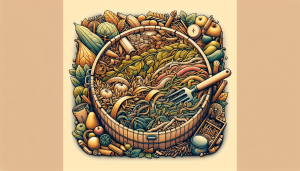What Is Bokashi Composting?
Bokashi composting is a fascinating and efficient way for us to transform our kitchen scraps into nutrient-rich soil amendments. With Bokashi, we can compost a wider variety of food waste—including meat and dairy—that traditional composting methods usually can’t handle. The process involves fermenting organic waste using a specific mix of microorganisms, and it takes much less time than conventional composting. Plus, it significantly reduces odors, making it ideal for those of us living in urban settings or dealing with limited space. Let’s dive into the world of Bokashi and discover how this unique method can revolutionize our approach to sustainability and waste management. Have you ever wondered how you can compost kitchen scraps quickly and efficiently, without the bad odor and pest issues that regular composting sometimes brings? Let us introduce you to Bokashi composting, a method that promises all the benefits of traditional composting, but with added simplicity and speed.
What is Bokashi Composting?
Bokashi composting, originating from Japan, is a fermentation process that converts food waste into a nutrient-rich soil amendment. Unlike traditional composting, Bokashi can compost almost all types of food waste, including meat and dairy products. This method involves fermenting organic waste using a special inoculated mixture known as Bokashi bran.
How Does Bokashi Composting Work?
The Bokashi composting system relies on anaerobic fermentation. This means that the process occurs without the presence of oxygen, thanks to a mix of beneficial microorganisms. These microorganisms break down organic material in an airtight container, transforming it into a pre-compost material that can later be added to soil for further decomposition.
The process is quite simple:
- Collect food scraps in a Bokashi bucket.
- Sprinkle Bokashi bran over the scraps to introduce beneficial microorganisms.
- Seal the container tightly to maintain anaerobic conditions.
- Wait for about two weeks for the fermentation process to complete.
- Bury the fermented material in soil or add it to a traditional compost heap for final decomposition.
Why Choose Bokashi Composting?
There are a plethora of reasons why we might choose Bokashi composting over other methods:
- Versatility: It can compost almost all food scraps, including meat and dairy.
- Speed: The initial fermentation process takes just about two weeks.
- Efficient Space Usage: Requires very little space, making it ideal for urban settings.
- Reduced Odor: Properly sealed Bokashi systems produce minimal smell.
- Rich Soil Amendment: The end-product is nutrient-dense and can significantly enrich garden soil.
Materials Needed for Bokashi Composting
Before we dive into the steps, let’s look at the materials you’ll need:
| Material | Purpose |
|---|---|
| Bokashi Bucket | The primary container for food waste collection and fermentation |
| Bokashi Bran | Inoculated mixture to introduce beneficial microorganisms |
| Food Scraps | Organic material to be composted |
| Airtight Lid | To maintain anaerobic conditions |
| Garden Soil/Compost Bin | For final decomposition after fermentation |
Choosing the Right Bokashi Bucket
When selecting a Bokashi bucket, consider the following factors:
- Size: Choose based on the volume of food scraps you produce.
- Design: Look for a tap at the bottom to drain Bokashi liquid, often called “Bokashi tea.”
- Material: Ensure it’s durable and resistant to leaks.
Understanding Bokashi Bran
Bokashi bran is typically made from a dry carrier such as wheat bran, inoculated with beneficial microorganisms like lactic acid bacteria, yeasts, and phototropic bacteria. These microorganisms are essential for the fermentation process. Bokashi bran can be purchased online or from garden stores, but some enthusiastic composters even make their own.
Step-by-Step Guide to Bokashi Composting
Let’s walk through each step in the Bokashi composting process:
Step 1: Setting Up Your Bokashi Bucket
Start by placing the bucket in a convenient location, such as under the kitchen sink or in a pantry. Make sure the bucket is clean and dry before adding your first layer of food waste.
Step 2: Adding Food Scraps
- Cut food scraps into small pieces: While not absolutely necessary, smaller pieces ferment more quickly and evenly.
- Layer food scraps evenly in the bucket.
- Sprinkle Bokashi bran generously over each layer of scraps to ensure they are well-coated.
Step 3: Sealing the Bucket
Once you’ve added a layer of food scraps and Bokashi bran, press the matter down lightly to remove air pockets. Doing this prevents the growth of mold and ensures an anaerobic environment. Close the lid tightly every time you add scraps.
Step 4: Draining Bokashi Tea
Every few days, you’ll notice a liquid accumulating at the bottom of the bucket. This is Bokashi tea, which should be drained using the tap:
- Collect Bokashi tea in a container and use it as a nutrient-rich fertilizer for your garden or houseplants.
- Dilute it at a ratio of 1:100 with water when using it on plants to avoid burning them.
Step 5: Completing the Fermentation
Once the bucket is full, let the contents sit sealed for about two weeks. Avoid opening the bucket during this time to maintain anaerobic conditions.
Step 6: Using the Fermented Material
After the fermentation period:
- Bury the fermented material in soil: Dig a trench at least 8 inches deep in your garden and cover it with soil. Alternatively, you can add it to your regular compost pile.
- Wait for further decomposition: The material needs another two to four weeks in the soil to break down completely before planting in that area.
Troubleshooting Common Issues
While Bokashi composting is straightforward, problems can occasionally arise. Here’s how to troubleshoot some common issues:
Bad Odor
If you notice a strong, unpleasant odor:
- Check for an airtight seal: Ensure the bucket is sealed tightly after every use.
- Use more Bokashi bran: Insufficient bran can lead to improper fermentation.
Mold Growth
White mold is generally harmless and a sign of healthy Bokashi. However, if you notice black or green mold:
- Add more bran: Insufficient beneficial microorganisms can lead to unwanted mold.
- Ensure proper layering: Make sure scraps are evenly layered and fully covered by bran.
Leaks
If your bucket leaks:
- Inspect for cracks: Ensure there are no structural damages or seams.
- Check the tap: Ensure it’s securely tightened.
The Environmental Impact of Bokashi Composting
Bokashi composting is not only beneficial for our gardens but also for the planet. Here’s how:
- Reduces landfill waste: Diverts food scraps from landfills, decreasing methane emissions.
- Conserves resources: Minimizes the need for synthetic fertilizers, reducing our carbon footprint.
- Promotes sustainable gardening: Enriched soil promotes healthier plants and reduces water needs.
Comparing Bokashi with Traditional Composting
Let’s compare Bokashi composting with traditional composting to better understand its benefits and limitations.
| Feature | Bokashi Composting | Traditional Composting |
|---|---|---|
| Composting Time | Initial stage: 2 weeks; Final stage: 2-4 weeks | Several months to over a year |
| Accepted Materials | Almost all food scraps (including meat and dairy) | Primarily fruits, vegetables, and yard waste |
| Space Requirements | Minimal (indoors or small outdoor space) | Requires a larger outdoor area |
| Odor Management | Minimal odor if done correctly | Can produce strong odors |
| End Product | Fermented waste, requiring further decomposition | Fully decomposed compost |
Applications of Bokashi Compost
When incorporated into soil, Bokashi compost enhances soil structure, nutrient content, and microbial life. Here’s when to use it:
In Vegetable Gardens
- Improves soil fertility: Enhances nutrient uptake for plants.
- Supports root development: Promotes stronger, healthier roots.
In Flower Beds
- Boosts bloom production: Provides essential nutrients for vibrant blossoms.
- Enhances soil moisture retention: Keeping flowers hydrated and reducing the need for frequent watering.
For Houseplants
- Mix into potting soil: Enhances the nutrient availability and supports healthy plant growth.
- Utilize Bokashi tea: As a liquid fertilizer for potted plants.
Making Your Own Bokashi Bran
Feeling adventurous? Let’s explore how you can make your own Bokashi bran at home.
Ingredients Needed
| Ingredient | Amount |
|---|---|
| Wheat Bran | 1 kg |
| Molasses | 2-3 tablespoons |
| Water | 1-1.5 liters |
| Effective Microorganisms | 1-2 tablespoons |
Instructions
- Mix molasses and EM in the water thoroughly.
- Combine liquid mix with wheat bran until evenly moist but not soggy.
- Store in an airtight container: Let it ferment for about 2 weeks.
- Dry the bran: Spread it out to dry, then store it in an airtight container.
Homemade Bokashi bran is cost-effective and adds a personal touch to your composting process.
Frequently Asked Questions
Can I compost paper products in Bokashi?
While Bokashi composting is designed for food waste, small amounts of paper products like coffee filters or paper towels can be added. Ensure they are minimal to avoid slowing down the process.
How often should I drain the Bokashi tea?
Drain the Bokashi tea every 2-3 days. Regular draining prevents an accumulation of liquid that could create an anaerobic environment and unpleasant odors.
What should I do if my Bokashi compost smells like rotten eggs?
A rotten egg smell indicates something has gone wrong. It could be due to a lack of sufficient Bokashi bran or an improper seal. Add more Bokashi bran and ensure the bucket is sealed tightly.
Is Bokashi composting suitable for large-scale use?
Bokashi composting is more suited for household and small-scale use. For large-scale composting needs, traditional methods or industrial composting might be more practical.
Can I add Bokashi compost directly to planting beds?
It’s best to bury Bokashi compost in soil and let it decompose for an additional 2-4 weeks before planting. This ensures that the material is fully broken down and the soil is ready to support plant life.
In Conclusion
Bokashi composting is an efficient, convenient, and environmentally friendly way to recycle kitchen scraps into valuable soil amendments. Whether you are an experienced gardener or a novice, Bokashi composting offers a manageable and odor-free composting solution.
By incorporating Bokashi composting into our routine, we can reduce waste, enrich our soil, and contribute to a more sustainable environment. Happy composting!



